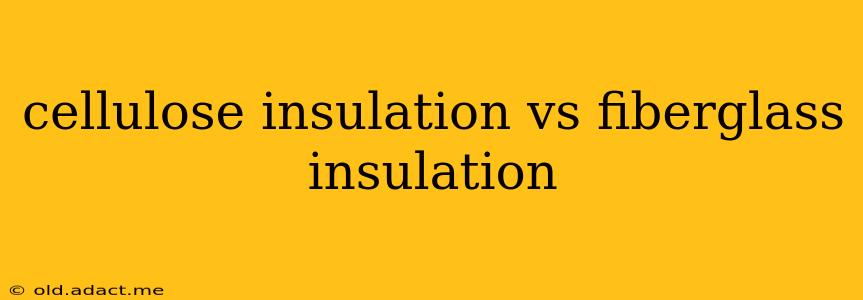Choosing the right insulation for your home is a crucial decision impacting energy efficiency, comfort, and long-term costs. Two popular options often top the list: cellulose and fiberglass. Both offer effective insulation, but they differ significantly in their composition, installation, and performance characteristics. This comprehensive guide will delve into the key differences, helping you determine which insulation best suits your needs.
What is Cellulose Insulation?
Cellulose insulation is a recycled material primarily composed of shredded paper, often treated with borates for fire resistance and pest deterrence. This eco-friendly option boasts excellent thermal performance, owing to its high R-value per inch. Its fluffy, dense structure creates numerous air pockets, effectively trapping heat and minimizing energy loss.
What is Fiberglass Insulation?
Fiberglass insulation is a manufactured product made from glass fibers bonded together. It's available in various forms, including batts, rolls, and loose-fill. Fiberglass is a widely used and readily available option, often chosen for its ease of installation in many applications. Its R-value is generally lower than cellulose per inch, but this can vary depending on the product's density and thickness.
Cellulose Insulation vs. Fiberglass Insulation: Key Differences
| Feature | Cellulose Insulation | Fiberglass Insulation |
|---|---|---|
| Material | Recycled paper, borate treated | Glass fibers |
| R-Value | Higher per inch | Lower per inch (generally) |
| Installation | Requires specialized equipment, often blown-in | Easier to install, batts and rolls are DIY-friendly |
| Cost | Can be slightly more expensive upfront | Typically less expensive upfront |
| Sustainability | Environmentally friendly, recycled material | Less environmentally friendly, energy-intensive production |
| Moisture Resistance | Absorbs moisture, requires proper vapor barrier | Less moisture-absorbent |
| Air Sealing | Excellent air sealing properties | Can leave gaps, requiring careful installation |
How Much Does Cellulose Insulation Cost?
The cost of cellulose insulation varies based on several factors, including the project's size, location, and labor costs. Generally, cellulose insulation's upfront cost might be slightly higher than fiberglass, but the potential long-term energy savings can offset this difference.
How Much Does Fiberglass Insulation Cost?
Fiberglass insulation is typically less expensive upfront than cellulose. Its readily available nature and simpler installation contribute to lower overall costs, making it a popular budget-friendly option.
Is Cellulose Insulation Better Than Fiberglass?
There's no single "better" insulation. The ideal choice depends on your specific needs and priorities. Cellulose excels in energy efficiency and environmental friendliness, while fiberglass often wins on ease of installation and lower initial cost.
What are the Pros and Cons of Cellulose Insulation?
Pros:
- High R-value per inch
- Excellent air sealing
- Environmentally friendly
- Fire-resistant (with borate treatment)
- Pest-resistant (with borate treatment)
Cons:
- More expensive upfront
- Requires specialized equipment for installation
- Can absorb moisture if not properly installed
What are the Pros and Cons of Fiberglass Insulation?
Pros:
- Less expensive upfront
- Easy to install (batts and rolls)
- Widely available
- Relatively lightweight
Cons:
- Lower R-value per inch (compared to cellulose)
- Can irritate skin during installation
- May not seal air gaps as effectively as cellulose
Which Insulation is More Eco-Friendly?
Cellulose insulation is undoubtedly the more eco-friendly choice. Made from recycled paper, it reduces landfill waste and minimizes the environmental impact associated with manufacturing.
Which Insulation is Better for Soundproofing?
Both cellulose and fiberglass offer some degree of sound dampening, but cellulose tends to perform slightly better due to its denser and more fibrous nature, absorbing sound waves more effectively.
Which Insulation is Better for Attic Insulation?
Both cellulose and fiberglass are suitable for attic insulation. Cellulose's excellent air sealing properties are particularly advantageous in attics, minimizing drafts and heat loss. However, fiberglass batts are easier to install for DIY projects.
Ultimately, the best insulation for your home depends on your budget, environmental concerns, DIY capabilities, and the specific characteristics of your home's construction. Consulting with a qualified insulation professional is highly recommended to ensure you make the most informed decision for your individual circumstances.
